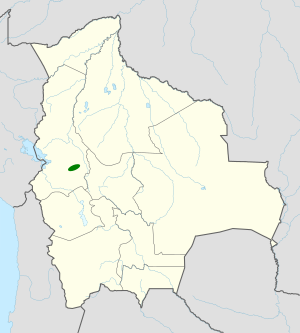Bolivian spinetail facts for kids
Quick facts for kids Bolivian spinetail |
|
|---|---|
| Conservation status | |
| Scientific classification | |
| Genus: |
Cranioleuca
|
| Species: |
henricae
|
 |
|
The Bolivian spinetail or Inquisivi spinetail (Cranioleuca henricae) is a special type of bird. It is part of the Furnariidae family, which includes many birds found in South America. Scientists first found this bird in 1993. They discovered it near a town called Inquisivi in the La Paz area of Bolivia.
Contents
Discovering the Bolivian Spinetail
This unique bird was first identified by scientists in 1993. Its discovery was an exciting moment for bird experts. They found it in the beautiful, diverse landscapes of Bolivia. The official scientific description of the bird was published in 1997.
Where Does the Bolivian Spinetail Live?
The Bolivian spinetail is an endemic species. This means it lives only in Bolivia and nowhere else in the world. Its natural habitats are specific types of forests.
What are its Favorite Places?
The Bolivian spinetail prefers two main types of places to live:
- Subtropical or tropical dry forests: These are warm forests that have a dry season. The trees here are adapted to less rainfall for part of the year.
- Plantations: These are areas where people grow trees or crops. Sometimes, these plantations can provide a home for the birds, especially if they are near natural forest areas.
Why is the Bolivian Spinetail Important?
Every species plays a role in its ecosystem. The Bolivian spinetail is a part of Bolivia's amazing natural heritage. Protecting this bird helps keep the balance of nature in its unique habitat.
What Threats Does It Face?
Sadly, the Bolivian spinetail is considered a vulnerable species. This means it is at risk of becoming endangered.
Losing Its Home
The biggest threat to the Bolivian spinetail is habitat loss. This happens when the places where the birds live are destroyed or changed.
- Forest clearing: Forests might be cut down for farming, building, or other human activities.
- Changes in land use: Areas that were once natural habitats might be turned into something else, like towns or large farms.
When these changes happen, the Bolivian spinetail loses its food sources, nesting sites, and safe places to live. This makes it harder for the birds to survive and have baby birds.
How Can We Help?
Protecting the Bolivian spinetail means protecting its habitat. Efforts are being made to conserve the forests where it lives. This includes setting up protected areas and encouraging sustainable ways of using the land. By learning about this bird, we can help spread awareness and support its survival.
See also
In Spanish: Curutié boliviano para niños


